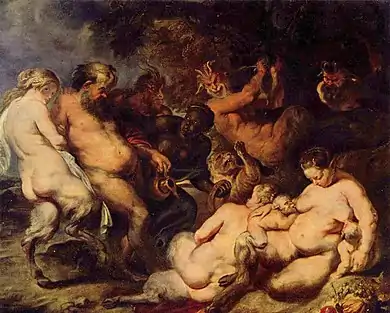Bacchanalia (painting)
Bacchanalia is a c.1615 oil painting of Bacchus, Silenus , bacchantes and satyrs by Peter Paul Rubens. Originally painted on panel, it was transferred to canvas by A. Sidorov in 1892.[1]

Rubens frequently returned to the theme of Bacchus, such as in his Drunken Hercules (1612-1618, Gemäldegalerie, Dresden) Young Bacchus Supported by Two Satyrs (post 1614, now lost but known through the engraving of Jonas Suyderhoef CG Voorhelm-Schneevoogt's engraving in Catalog des estampes gravees d'apres PP Rubens, Haarlem 1875, p.133.), Sylvester's Retinue (1618, Alte Pinakothek, Munich) and the studio work Bacchanalia (1612-1614, Palazzo Durazzo-Pallavicini, Genoa). They all draw on classical art, particularly a relief sculpture of a drunken Hercules and Bacchic sarcophagi scenes - one of the latter is now in Moscow and was known to Rubens, who based a sketch entitled Drunken Heracles with a Faun on it.[2]
It was recorded in 1735 in Robert Walpole's collection at Houghton Hall before being bought for the Hermitage Museum in 1779, before being transferred to the Pushkin Museum in 1930.
References